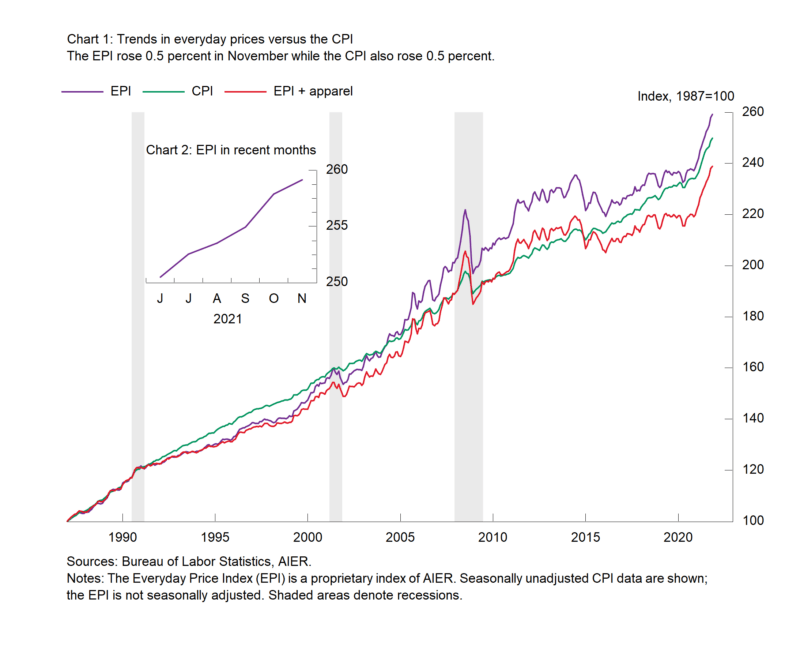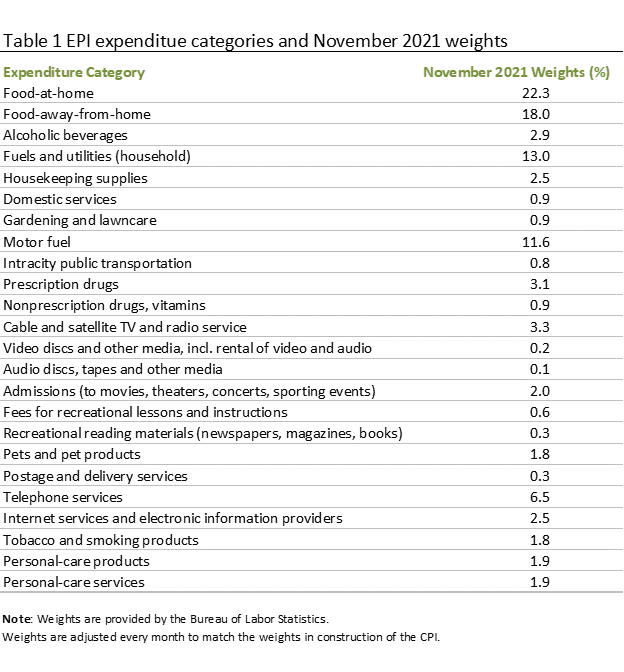AIER’s Everyday Price Index Posts Its 12th Consecutive Increase
The AIER Everyday Price Index posted its 12th consecutive monthly increase in November, rising 0.5 percent. The gain follows a 1.2 percent jump in October. From a year ago, the Everyday Price Index is up 9.3 percent, the fastest pace since September 2008.
Gains were again widespread with 17 of the 24 components making a positive contribution for the month. However, most of the changes were small for the month as just three categories accounted for all of the monthly gain. The positive contributions were led by motor fuel, up 2.8 percent for the month (and 58.0 percent for the year) and contributing 31 basis points to the monthly gain. Food away from home (a.k.a. restaurants) was the second-largest contributor to the increase in November, contributing 11 basis points to the gain while food at home (a.k.a. groceries) added 8 basis points. Household fuels and utilities fell in November subtracting 1 basis point. Combined, food and energy categories have a weighting of 64.9 percent of the Everyday Price Index. Six other categories posted small declines in November.
The Everyday Price Index including apparel, a broader measure that includes clothing and shoes, rose 0.3 percent, also the 12th consecutive increase. Over the past year, the Everyday Price Index including apparel is up 9.0 percent, the fastest pace since August 2008. Apparel prices fell 1.6 percent on a not-seasonally-adjusted basis in November. Apparel prices tend to be volatile on a month-to-month basis. From a year ago, apparel prices are up 5.0 percent.
The Consumer Price Index, which includes everyday purchases as well as infrequently purchased, big-ticket items and contractually fixed items, also rose 0.5 percent on a not-seasonally-adjusted basis in November. Over the past year, the Consumer Price Index is up 6.8 percent, the fastest pace since June, 1982, but significantly less than the 9.3 percent rise in the EPI.
The Consumer Price Index excluding food and energy rose 0.4 percent for the month (not seasonally adjusted) while the 12-month change came in at 4.9 percent, the fastest since June 1991. The 12-month change in the core CPI was just 1.3 percent in February 2021 and 2.4 percent in February 2020, before the pandemic.
After seasonal adjustment, the CPI rose 0.8 percent in November while the core increased 0.5 percent for the month. Within the core, core goods prices were up 0.9 percent in November and are up 9.4 percent from a year ago while core services prices were up 0.4 percent for the month and are up 3.4 percent from a year ago.
Among the notable increases in the core goods category were used cars and trucks (up 2.5 percent and 31.4 percent from a year ago), new vehicles (up 1.1 percent and 11.1 percent from a year ago) and tobacco products (up 0.9 percent and 8.9 percent from a year ago).
Among core services, gainers include car and truck rentals (up 1.1 percent and 37.2 percent from a year ago) and lodging away from home (up 2.9 percent and 22.2 percent from a year ago).
Price pressures for many goods and services in the economy remain elevated due to shortages of supplies and materials, logistical and supply chain issues, and labor problems. As activity returns to normal, supply and demand will adapt and likely lead to slower price increases, but it may take some time before the economy completely returns to normal functioning. Recurring waves of new Covid cases will likely prolong the process.
Note: The Everyday Price Index for October is based on incomplete data due to restrictions on data collection by Bureau of Labor Statistics personnel because of the Covid-19 pandemic.







